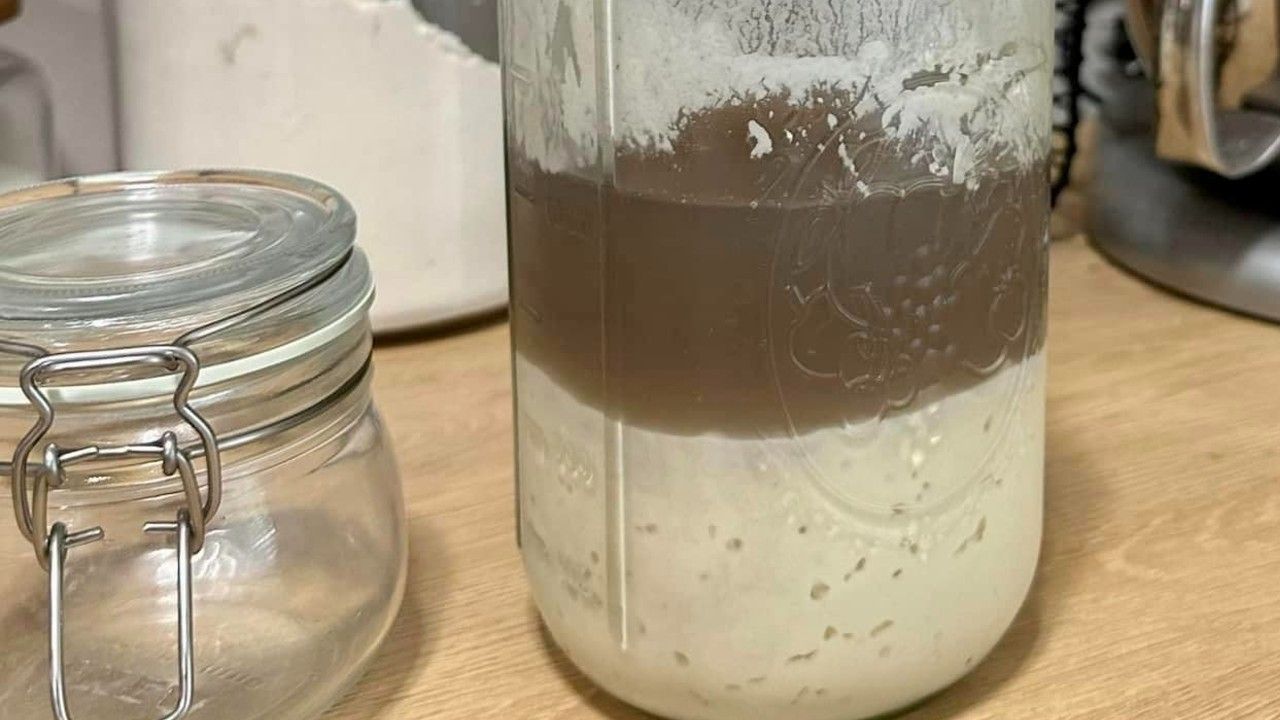
What is hooch? Do I stir it in or pour it out?
Questions we get daily. Let’s start from the top.
You know that weird, brown-gray, cloudy liquid that forms on top of your starter when it hasn't been fed for a while? That’s called hooch in the sourdough world.
Hooch consists of water, ethanol and other organic alcohols and VOCs (volatile organic compounds). It’s the waste products of both yeast and lactic fermentation in a solution of water. In order for it to develop in the first place, the starter must be starved of food for a considerable amount of time.
Why am I getting hooch on my starter?
Short answer: it’s really hungry. You can refrigerate a starter for around 3-7 days before hooch begins to develop. Once it starts developing, it goes through a couple of stages.
- A clear liquid begins to form on the surface of the starter.
As the yeast is still fermenting, at a slow rate, the waste and by-products from fermentation are accumulating. The pH level of the starter continues to fall as organic acids increase in concentration. Optimal pH for most yeast growth and fermentation in a sourdough system is between 4.0-6.0. However, sourdough yeast are acid tolerant and will continue to ferment at lower pH, just at a slower rate. As acidity increases (due to falling pH), the yeast begins to undergo stress.
*At this stage, you could probably just stir your hooch back into the starter. - The liquid completely covers the surface and begins to discolor.
Often it starts out yellow then gray and finally darker gray or black due to oxidation. But it also serves to protect the culture underneath from contamination as the culture goes into survival mode. The stress that the yeast undergo at this point actually physically deforms them, and they often behave erratically once the culture is refreshed as a result. So not only is hooch a clear indicator of a culture in distress, but there are also knock-on effects from acid load, off-flavors from VOCs and deformed yeast which then negatively affect the culture once refreshed.
To Stir or Not to Stir?
There are widely varying opinions on this topic, but at Sourdough Geeks, we’re team no-stir.
Stirring in your hooch can have different consequences based on the stage of your hooch. It could damage your active yeast and also affect the flavor negatively. Others say that stirring in hooch helps keep the starter hydration at the right levels and adds to the sour flavor. We just think that the cons outweigh the pros of stirring in.
Our recommendation is to pour or scoop off the hooch and feed your starter normally. It doesn’t need to be perfect, just do your best to get the bulk of the hooch off of your starter. This will immediately raise the pH, and will allow a significant amount of new yeast growth to make up the majority of the new yeast population.
From there, giving your starter a regular feed should restore the culture to a healthy pH level, and correct the balance between yeast and lactic acid bacteria populations. No more hooch!

How to Prevent or Treat Hooch
If your starter is consistently producing hooch, you may want to try changing a few things in your process.
Here’s what we suggest trying:
- Increase the regularity of feeding.
If your starter sits on your counter, or outside of the refrigerator, try feeding it once every 12 hours instead of once every 24 hours. This should ensure your starter is properly fed which will stop the hooch-producing process. - Store your starter somewhere cooler.
At Sourdough Geeks we recommend keeping it somewhere that is consistently 69-70 degrees Fahrenheit or less. The warmer your starter is, the faster the starter consumes its feeds. So, placing it in a cooler location should quell its appetite enough to reduce the odds of forming hooch. - Feed a higher ratio.
Your sourdough starter could just be hungry! Instead of 1:1:1, try 1:2:2 or even 1:3:3 to give it a solid foundation and then go back to normal feeds if you don’t see hooch forming.
The methods we use evolve with our understanding. There are countless ideas I once treated as gospel which are no longer part of anything I do today. We do what works best for us until we discover an idea that works better. As I wrote in my S.O.U.R. framework, there are no right of wrong ways to make sourdough. But there are fundamental fermentation science truths that underpin everything we do, whether we recognise them or not.
Ultimately, there are myriad ways to handle hooch and you’ll find the way that works best for you. What do you think? Are you team stir, or team no-stir? Tell us about your experiences (good and bad) with hooch in the comments below.
🤓 LEVEL UP YOUR LOAVES! Become an Official Geek for just $5/month (or $50/year) and unlock the good stuff: free courses, video tutorials, live bake-alongs, secret recipes, tasty discounts, our private geek HQ, and BREAD TALK — our twice-monthly, real-time video hangouts.
👉 Not quite ready to go full geek? No worries — you can still snag our Mastering Sourdough Starter course for just $19.99 here.

